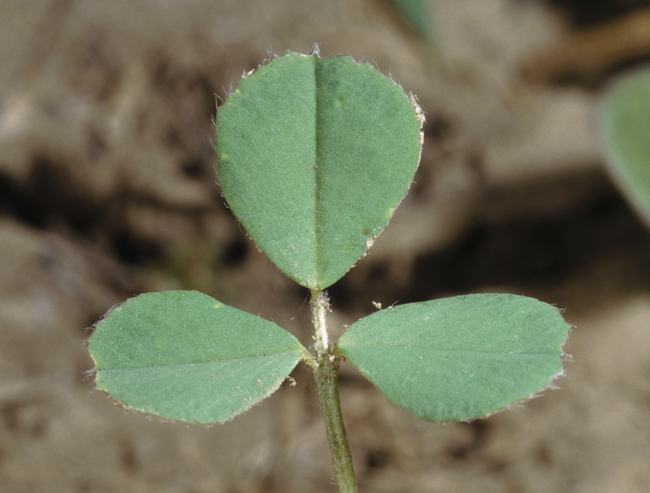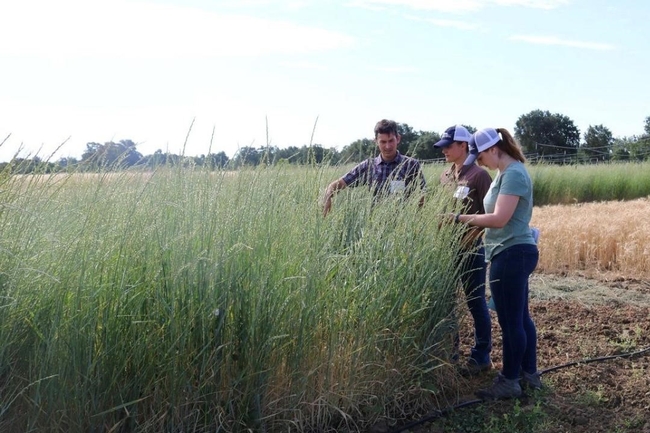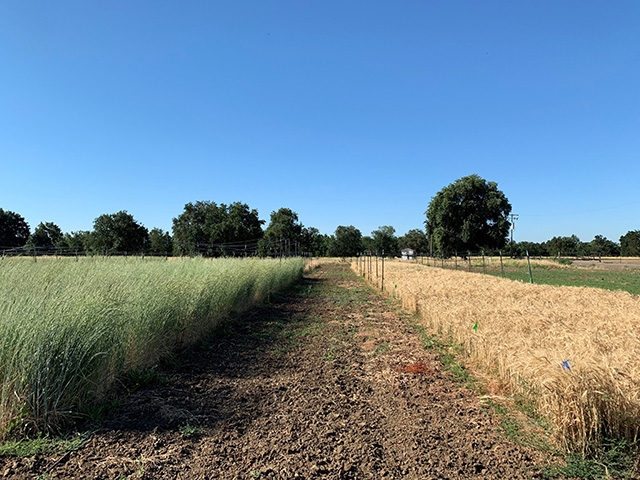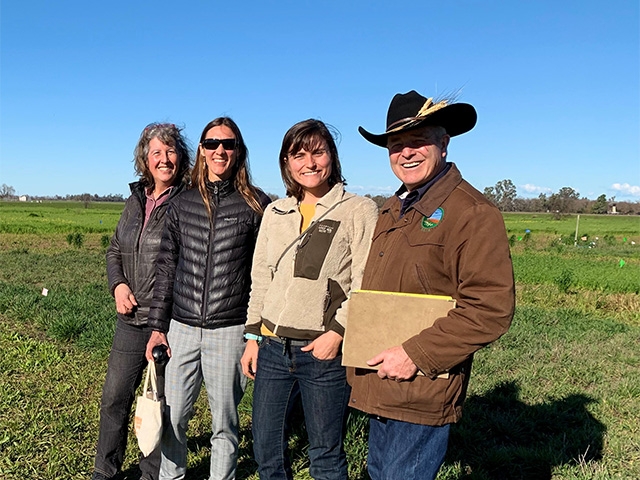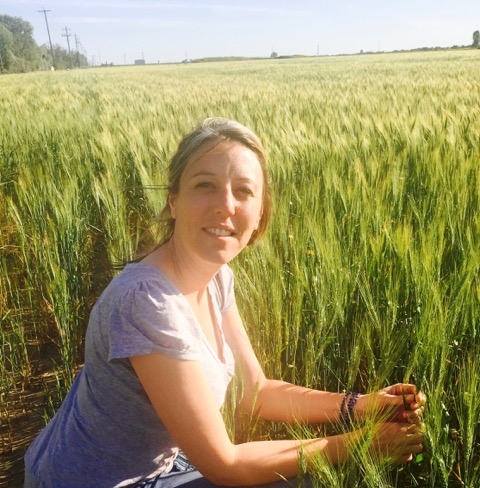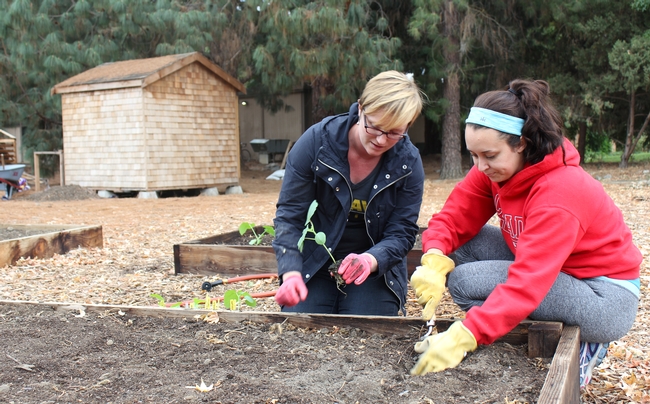Posts Tagged: soil
California Plant and Soil Conference set for Feb. 6-7 in Fresno
The 2024 California Plant and Soil Conference will be held Feb. 6-7 at the DoubleTree Hotel in Fresno. The conference is organized by the California Chapter of the American Society of Agronomy and UC Cooperative Extension.
This year's conference will cover the following topics:
- Are we ready? Adapting agronomy to an uncertain future
- Precision agriculture
- Nutrient management
- Micronutrients
- Animal-plant systems management
- Soil management
- California IPM toolbox
- Pesticide resistance
- Bees, pollinators
- Groundwater recharge
- On-farm water management
“The diverse topics covered at the annual California Plant and Soil Conference are determined by polling members each year about what information is most important for them to learn about regarding sustainable agricultural production in California,” said Nicholas Clark, conference organizer and UC Cooperative Extension farm advisor, who specializes in agronomy and nutrient management.
Growers, pest control advisers and crop consultants, allied ag industry professionals, academics, and government agency staff attend this accessible, science-based conference each year to stay up-to-date on major issues in California agriculture and their potential solutions. In addition to networking opportunities, the conference offers continuing education credits for growers and other ag professionals seeking to maintain various licenses.
“Another really cool thing about this conference is that the chapter has a strong career development component to it,” said Clark. “We support students through financial assistance to attend as poster presenters, and we give monetary awards to student poster contest winners judged by members of the CA ASA board and industry professionals. We also have a merit-based scholarship award given to students each year for their contributions to and potential in the agricultural industry and science fields. These awards are largely supported by private sponsors and member dues.”
The annual conference provides an opportunity for all attendees to increase their knowledge of current topics of agronomic importance in California. By attending the conference, certified crop advisers and pest control advisers can earn continuing education units that are important to their professional standing.
The agenda for the conference includes several new items this year:
- Two additional sessions with six speakers will be offered on the afternoon of Feb. 7 after the business lunch.
- A student-mentor breakfast meeting will be held the morning of Feb. 7 with round-table discussions to hear about mentors' experiences and career paths in agricultural science fields, providing a chance to network and broaden perspectives.
In addition to presentations, there will be an award ceremony to honor individuals who served the profession through their careers, a student poster competition, non-competitive professional posters, and the CA ASA business meeting. Sponsorship opportunities are available to support student participation. For more information, please see the conference website at https://na.eventscloud.com/website/58588/sponsors.
Registration is $375. Early bird registration is $325 and ends Jan. 12. Registration on site will be $425. Register through the conference website: https://na.eventscloud.com/plantandsoilconference.
The conference is planned and presented by a team of volunteer professional agronomists from research institutions, UC Cooperative Extension, public agencies and private companies. If you are interested in serving on the board or have questions about the conference, please contact a current board member (https://na.eventscloud.com/website/58588/leadership).
The California Chapter of the American Society of Agronomy was founded in April 1971 by a group of California agronomists who recognized the value in creating a forum to focus on California agriculture. The purpose of the annual meeting is to promote research, disseminate scientific information, foster high standards of educational and ethical conduct in the profession, and facilitate robust cooperation among organizations with similar missions.
No-till annual wheat better for soil health in California’s climate
One more reason to adopt sustainable cultivation
California wheat farmers could both maintain their yields and improve soil health by growing annual wheat without tilling the soil year after year.
This could be one more encouragement to farmers to adopt a sustainable practice commonly called conservation tillage, no-till or minimum-till cultivation, impacting how we grow a grain that supplies about 20 percent of the calories and protein for people around the world.
A new study, by a team led by Mark Lundy, University of California Cooperative Extension specialist in UC Davis' Department of Plant Sciences, offers new insight for decades-long discussions around soil conservation, sustainable agriculture and climate-warming emissions related to growing our food. The study has been published in the journal Soil and Tillage Research. For the first time, researchers have shown that annual wheat that is not tilled each year is better for stashing carbon in the soil than perennial wheatgrass, while still yielding more crop in Central California.
Previous studies have looked at annual wheat that is tilled each year, annual wheat that is not tilled, and a cousin species, perennial intermediate wheatgrass (trademarked Kernza), which also is not tilled. But until now, no one has looked at all of the benefits and trade-offs together. Most importantly, “no one has ever controlled for tillage,” Lundy said. “And, no one has compared annual wheat to perennial intermediate wheatgrass over multiple years in a Mediterranean climate, which is what we have in California.”
This study also is unique because it delves into the deeper question of what is going on in the soil that drives the different results for carbon there. Soil carbon reflects various processes linked to plant activity and soil health. Measuring the different forms of soil carbon may also signal whether a farming system is accumulating carbon in the soil over time – a plus for reducing climate-warming gases in the atmosphere.
“Measuring soil carbon is complex and nuanced,” said Kalyn Taylor, the lead author on the paper. “We started this experiment because we wanted to know whether and how plant activity and tilling or not tilling would affect the carbon story belowground in California's climate.”
“When we started this study, we thought the crop being perennial or annual would drive the differences in carbon storage in the soil,” Lundy added. Specifically, they had expected perennial wheatgrass would lead to more carbon in the soil because of its deeper, better-established root system. “But that's not what we found,” he went on. “What we found was, it was the lack of tillage, plus the level of productivity of common annual wheat, that made the difference in soil carbon here in California.”
Soil carbon in annual vs. perennial grain
In 2017, Lundy, then-graduate-student Taylor, UC Davis Professor Emeritus Kate Scow and others on the team started measuring different forms of soil carbon in test plots at Russell Ranch, west of campus. Plots were planted with annual wheat that was tilled each spring, annual wheat that was not tilled and perennial intermediate wheatgrass (Kernza) that also was not tilled.
Each year, the researchers measured the carbon present in the soil, the amount of soil organisms (which have carbon in their bodies) and the amount of material the plants created.
At the end of three growing seasons, they found that land planted with no-till, common, annual wheat had the highest amount of soil organisms, measured as biomass, of the three treatments.
The researchers also found soil carbon is more likely to remain stable in the no-till, annual plots, compared to both tilled wheat and wheatgrass.
In addition, the no-till, annual wheat produced plant material more consistently than the perennial wheatgrass across the three years, which saw variation in rainfall.
“Overall, annual wheat grown without soil disturbance or tillage had both higher productivity and higher potential for storing carbon in the topsoil than perennial wheatgrass in our Mediterranean climate,” Lundy said.
Related research
“No-till annual wheat increases plant productivity, soil microbial biomass, and soil carbon stabilization relative to intermediate wheatgrass in a Mediterranean climate,” is online now and will be published in the January 2024 edition of Soil and Tillage Research.
The team also found that tilled annual wheat vs. Kernza stores total carbon at different depths in the soil profile and hosts distinct soil fungal communities, primarily in the root zone and topsoil: Taylor, K., Samaddar, S., Schmidt, R., Lundy, M. and Scow, K., 2023. Soil carbon storage and compositional responses of soil microbial communities under perennial grain IWG vs. annual wheat. Soil Biology and Biochemistry, p.109111.
Previous work comparing the perennial grain known as intermediate wheatgrass (trademarked Kernza) to annual wheat had not distinguished the extent to which soil health benefits are a function of the perennial nature of the crop. Read the story here.
This story was originally published on the UC Davis News site.
Agroecology, internationally and at home
For many years, a key international strategy to ending hunger has been to grow more food: push for higher yields, develop ways for farmers to intensify their farming, focus on technologies that drive both. But that focus may be shifting towards another strategy that better accounts for the environment and human well-being – agroecology.
Barbara Gemill-Herren, a retired officer from the Food and Agriculture Organization of the United Nations, spoke recently at UC Davis of the ongoing process at the United Nations to determine an international strategy for agricultural development.
For many, a new paradigm needs to strike a balance between supporting small-scale farmers, supporting healthy ecosystems, and bringing in the technology that can help meet changing challenges for growers.
Agroecology has recently entered the vocabulary at the UN as a potential unifying principle for agricultural development.
As its name suggests, agroecology studies the ecology of the entire food system, focusing on environmental, economic and social dimensions and how they interact with one another.
Beyond that definition, the term is used and understood differently by different groups. For some, agroecology is a scientific discipline, for some it represents a way for farms to be managed. For others, it is a social movement that brings local and indigenous knowledge to the center of agricultural development.
At the United Nations meetings on agroecology, each of these interpretations of agroecology have been on the table for discussion — how they can be used to improve international agricultural development will be revealed in global conversations in the years to come.
Agroecology endowment at UC Davis secures research opportunities
Here at home, agroecology is on the upswing as well. Funding for a $1 million endowment in agroecology was recently secured at UC Davis to help fund the research, education, and outreach conducted by an agroecology faculty member. Collaborating with UC Cooperative Extension farm advisors from UC Agriculture and Natural Resources will be a key way for future work to connect with growers.
Endowments offer reliable funding every year that allow faculty to plan longer term research. For research like agroecology that looks at how agricultural systems function, that flexibility is important, if not essential.
Tom Tomich, director of the Agricultural Sustainability Institute, which helped raise funds for the endowment, says, “The endowment represents at a broad spectrum of philanthropists and shows that scientific approaches to agroecological systems science is appreciated by our stakeholders in California. It's a form of legitimization of systems science applied to agriculture.”
Opportunities for collaboration between researchers and farmers
For Amélie Gaudin, assistant professor of Agroecology at UC Davis, agroecology is on a promising path toward sustainability for California agriculture. Gaudin started working at UC Davis in 2015 and is building her research and community relationships.
Below are some thoughts from Gaudin on how she approaches her work and how she sees this agroecology endowment impacting research and education at UC Davis.
How do you define agroecology?
There are different definitions of agroecology for different people. Mostly I see it as research to understand dynamics of ecological processes and to apply ecology to agricultural systems design. Agroecology merges the food security and production goals of agriculture with resource use efficiency goals and environmental goals in agriculture. For many people, agroecology is a social movement to make systems socially just. While my focus is largely on biological processes, it's also about learning from small-scale farmers who have been successful in their management practices to see how we can translate those successes to other contexts. And that is very social in nature.
At what scale do you research?
Usually we tend to work at the field scale, looking at cropping systems and the landscapes that surround them. Looking at the field, we can see how the long term management of a farm has affected the soil and its functioning as well as productivity and provision of multiple other ecosystem services. Looking at the surrounding landscape, we can understand what the natural environment has provided to the farm system, and what the farm system provides back to the natural environment. Sometimes we look a meter out, sometimes a kilometer out.
But beyond just the space we look at, we're really looking at time. Nature takes time. When you look at the field, it's an observation of what has been going on there for a very long time.
How does agroecology research work with farmers?
Working with farmers helps give research the long-term lens and management gradients we need to understand these agricultural systems, and gives us a landscape lens that many research fields can't provide. It also helps relate our research to production constraints that farmers have.
There is also tremendous innovation in what farmers are coming up with. They have a specific problem and they usually have tried specific solutions. They test things out, they monitor their fields and see results, but maybe don't understand fully the underlying mechanism and potential impact on the environment. We try to get to the why; we try to connect the dots to enable scaling up and better understanding of the ecological processes regulating resource use efficiency.
We're also looking a lot at resilience to stresses. And we find more and more interest in this because resources are not plentiful anymore and we now have to produce more with less. So how do we build resilience to the multiple stresses that come along? Are there ways that the management of a farm can impact productivity when a stress like drought occurs?
We have a lot to learn from small growers and a lot to learn from growers who have constrained resources about what they have been implementing and experimenting with. How can we transfer those practices to different environments? How can we scale them up?
How can we make it work in large-scale agriculture? There's a huge opportunity there. I want to see agroecological approaches to management implemented all over the Midwest, all over the Central Valley. I think agroecology is compatible with large-scale agriculture and critically needed.
How do you approach research questions?
I start with the problems a farmer didn't have. One project started with a tomato farmer who didn't have the same insect problem that surrounding farms had. So we ask, what is he doing that created this insect resistance, and how can that be used by other farmers? We met with several different farmers to discuss the issue, and wrote a grant to investigate specific hypothesis across a management gradient.
We're now working with five different growers and using Russell Ranch, our long-term agricultural research facility, as a benchmark.
I think conversation with farmers and their advisors is critical to develop relevant research questions and alternatives which have conservation of natural resources, biodiversity and provision of ecosystem services as a basis for improvement. It is also important to keep a positive feedback loop and bring results back to the community to foster farmer-to-farmer knowledge transfer.
What excites you about this new investment in agroecology?
The context of agriculture is changing and we now have a tremendous opportunity to promote agroecology as a viable and necessary strategy to build the sustainability and resilience of our agriculture. Farmers are seeking solutions, they are aware and interested. With climate change and depleted resources becoming more of a reality, growers are interested in putting soil improvement and ecological principles back into their management framework. And I think we ultimately care about the same things, we just need to find common ground and start speaking the same language. To do it we have to be open minded, both on the researcher and farmer side.
Investment in agroecology will help us reach this objective and gives us an opportunity to think outside of the box. This gives an opportunity to be creative, cope with some of the pitfalls of science funding and take a participatory approach to interdisciplinary research to design holistic solutions that better use nature for a sustainable agriculture.
How will you celebrate World Food Day?
Each year on Oct. 16, the world takes a moment to raise global awareness of agriculture, hunger, and food issues. World Food Day officially marks the anniversary of the creation of the UN's Food Agriculture Organization (FAO) in 1945, and nowadays it aligns with other global events such as this week's World Food Prize activities in Iowa.
Food and agriculture are central to what UC Agriculture and Natural Resources (UC ANR) professionals deal with every day. We're elbows-deep in solving specific problems like pest identification, childhood nutrition in schools, drought-tolerant plant breeding and spreading sustainable agricultural practices.
World Food Day is a day for all of us to take a step back and look at the bigger picture. Here are some ways that UC ANR faculty are raising awareness on World Food Day this year. How will you join them?
If you're near UC Davis, two free events invite the public to mark World Food Day:
America's Farm-to-Fork Capital Speakers Series offers participants lunch and an in-depth discussion of the connections between soil health, farm health, healthy foods, and the gut microbiome. These themes are particularly pertinent this World Food Day, as it is also the International Year of Soils. Author Daphne Miller will speak about her book "Farmacology" and then join a panel of academics from UC ANR's Agricultural Experiment Station, specifically Kate Scow and Bruce German, moderated by Tom Tomich. The event will be 11 a.m. – 1:30 p.m., Friday, at the Buehler Alumni Center on the UC Davis campus. Event details and registration
The Grand Opening of the Horticulture Innovation Lab Demonstration Center will send participants home with a souvenir vegetable seedling and a closer look at some of the technologies and crops that UC academics work with in developing countries. UC ANR Cooperative Extension specialist and pomologist Elizabeth Mitcham is also the director of the Horticulture Innovation Lab and will be joined by Rep. Ami Bera (D-CA), UC Davis CA&ES Dean Helene Dillard, and others to discuss the work that UC Davis and its international partners do to help small-scale farmers in developing countries. This event is particularly pertinent as this year's theme for World Food Day focuses on how agriculture can break the cycle of rural poverty. The event will be at 2 – 3:30 p.m., Friday, on Solano Field, near Nelson Hall on the UC Davis campus. Event details and information about the new demonstration center
Online this week, you can hear UC ANR academics Dan Sumner and Christine Stewart speaking on a panel at the World Food Prize Borlaug Dialogue, broadcast online via a live stream. They will be speaking 1:30 p.m. PDT, Wednesday, on a panel with UC Davis' Roger Beachy about the UC Davis World Food Center, “Launching a New Initiative - Food for a Healthy World.”
More information about World Food Day can also be found on the FAO website or by browsing #WFD2015 in social media.
Strawberry fields forever
Methyl iodide – yes, that volatile chemical that could find use as a soil fumigant – has been in the news lately, and mostly in a negative light. In April, California’s Department of Pesticide Regulation made a preliminary decision to approve the use of methyl iodide as a fumigant under strict conditions, and soon after received more than 50,000 public comments.
Methyl iodide, it turns out, is not only toxic, like all fumigants, it “can cause cancer, brain damage and miscarriages.” Its potential use in California’s strawberry fields in place of its ozone-depleting and toxic cousin, methyl bromide, is what shot the compound into news orbit.
Why phase out methyl bromide as a soil fumigant? Answer: Ozone loss up in the stratosphere, leading to more ultraviolet light penetrating the Earth’s atmosphere, leading, in turn, to increases in skin cancer. When methyl bromide is released in the lower atmosphere, a fraction gets transported into the stratosphere where it undergoes a series of chemical reactions leading to stratospheric ozone depletion.
Cousin methyl iodide, on the other hand, is photolyzed quickly in the lower atmosphere, leaving none of it to escape into the stratosphere.
While public opinion currently leans heavily against the use of methyl iodide as a soil fumigant replacement, James Sims, a professor emeritus of plant pathology at UC Riverside, supports its use. For one thing, it delivers results similar to methyl bromide, he says, and, second, it can be used safely. He explains that it is not applied directly to plants; it is injected into the soil two weeks before any plants are planted.
Methyl iodide is a liquid boiling at 42.5 degrees C or 108.5 degrees F. Sims says it is therefore safer for workers to handle than a gas like methyl bromide. Moreover, it can be applied using the same equipment with few or no modifications, and it is effective in reducing pest, weed and plant disease problems. Other alternatives — solarization, anaerobic soil disinfestations, crop rotation, steaming, etc. — are not effective, Sims says.
Critics are not convinced of methyl iodide’s relative safety and growers, meanwhile, continue to insist that their fields need a fumigant that poses no harm to our precious ozone layer.
How then might the controversy play out? We will have to wait and see – for several weeks at least. After processing the public comments received, state officials plan to weigh in on the “controversial effort to register the fumigant methyl iodide.”


